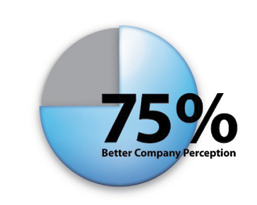We sometimes forget that our customers’ perceptions are our business’ reality. When customers call your business and wait on hold for a few minutes, they perceive that you don’t care enough about them to answer the call immediately. Some contact center professionals may disagree. After all, we wait for things every day. We wait for the coffee pot to finish brewing. We wait for the light to turn green. We wait for our popcorn to finish popping, and we’re not bothered. But a 2008 survey found that waiting on hold was the second biggest frustration for customers… and a confusing IVR – Interactive Voice Response – menu was first!

Eric Camulli
Vice President
Virtual Hold Technology
Akron, OH USA
This is because customers often don’t know how long they will be on hold. So the minutes can seem like hours. As time keeps ticking, your customers’ emotions escalate from annoyed, to aggravated, to flat-out insulted. Eventually, they will reach a threshold of intolerance where they begin to question why they are even doing business with your company. By the time a service representative comes on the line, the customers are ready to vent – if they’re still there, that is.
Often, the anger is justified. Electricity is an essential element of everyday life. Customers who call their electric companies often are in dire straits. They may be sitting in the dark with a refrigerator full of thawing food, and they can’t find out when the power will come back on. Even less serious situations, such as billing questions, can create anxiety for customers who are tethered to the phone instead of free to go about their daily activities. Whatever the issue, the customer wants answers... now.
The State of the Customer
It might be possible to avoid damaging customer relationships if companies knew where to locate this threshold of intolerance. For example, if the companies’ contact center agents could identify when customers start to feel aggravated, we would be able to implement a strategy to ensure that, at worst, they would reach only the annoyance level of customer dissatisfaction.
Unfortunately it’s an impossible strategy to implement. Every customer’s breaking point is different. The when and why behind each person’s intolerance is dependent upon a myriad of variables that change every day. Things like prior experiences, expectations and people’s moods may be different each time they pick up the phone and call you. Waiting on hold for two minutes may be perfectly acceptable one day but the “last straw” the next.
Additionally, people’s patience has grown shorter in the Internet age. The phenomenal growth of online social networking and mobile communication has created a cultural shift in our society. Specifically, these new media are creating a more demanding consumer who expects immediacy, convenience and transparency.
Perhaps most important for electric companies, the community aspect of social media fosters strength in numbers. No utility wants to create an army of disgruntled customers who will rise up when they are unsatisfied with the company’s offerings or service.
While existing technologies such as self-service IVR strategies are suitable for tasks like paying bills or cancelling service, today’s customers don’t want to wait for prompts in more urgent situations. They want to talk to a human being about the issue and receive verbal confirmation that the company will take care of it. They also want to speak with someone immediately. Customer complaints have already led many state public utility commissions to regulate hold times and dictate that utilities must answer most calls within a certain time limit.
For that reason, providing positive customer experiences is more important than ever before. Tangible experiences with a company are all that customers have when considering whether or not they are satisfied with a company. They are not privy to the company’s excellent first-call resolution rates and high service-level attainment metrics for the month, nor do they care. All they know, as customers, is that when they tried to call, they waited on hold, and hated it. And then they told several friends.
Taking Customer Relationships Off Hold
The good news is that technological advances have also created new ways for utility companies to keep their customers satisfied today. A virtual queuing solution educates and empowers customers with respectful options for managing time. When a customer calls in and the expected hold time is longer than a certain limit (generally two minutes), the customer hears a message that reports the expected wait time and gives the caller a choice of whether to continue to hold or request a callback. The callback comes in the same amount of time they would have waited on hold, without losing their place in line.
With virtual queuing, callers still have to wait for a response, but the experience is completely different than holding on the line. Sitting on the phone for just a few minutes can seem like an hour, but when the caller is able to hang up the phone, it’s almost as if time has been added back into their lives.
More than 70 utility companies in the United States already boast this technology. The Hawaiian Electric Company and Pepco Holdings, for example, have been ahead of the curve in employing the technology to make the most of their customers’ time.
Hawaiian Electric prides itself on outstanding customer service, but 2008 price increases and service delays stressed the contact center, resulting in higher-than-normal call volumes and, consequently, long hold times. Virtual queuing made it possible to manage the call volumes without keeping customers on hold. In just the first three months, Hawaiian Electric helped its customers avoid years of hold time without over-staffing its contact center. An additional, unexpected benefit was the impact the virtual queuing solution had on employee morale: instead of conversations beginning with complaints about waiting on hold, conversations are starting with compliments on the virtual queuing option.
On the other side of the United States, Pepco Holdings in Washington, D.C., has offered virtual queuing options since 2003 and, in that time, it’s become a mission-critical application in the contact center, saving two million minutes per year and boosting the efficiency of its agents. When the contact center experiences high call volume, the virtual queuing solution intercepts the call, informs the caller of the estimated wait time, and offers the caller the virtual queuing callback. Typically more than 50 percent of the callers elect to join the virtual queue; the ones who do choose to hold are less likely to hang up because they know how long they’re going to have to wait. Reconnection rates with top-tier virtual queuing solutions are typically well over 90 percent, and Pepco usually sees a 94 percent successful reconnection rate.
In general, when Virtual Hold Technology is treating calls, utility companies using this technology saved their customers 5.7 years of hold time in one year and improved other contact center metrics, including:
- a 60% boost in average speed of answer
- a 56% improvement in service level
- a 57% improvement in abandon rate
It’s About Time
Almost every executive will state a commitment to customer satisfaction. Yet, customers continue to experience bad service because the operational expenses required to elevate customer service (technology and head count) are traditionally slashed, thus perpetuating service mediocrity. It doesn’t have to be this way. Technology that improves the customer calling experience is cost-justifiable.
Because the services provided by utilities are so essential and because call volume to utilities literally changes with the weather, there’s no ideal staffing level in the call center. That is why many utility companies are turning to the latest call center technologies to take their customers off hold and make better use of everyone’s valuable time. With virtual queuing technology, a company can offer its customers a more predicable experience regardless of the situation. This not only increases customer satisfaction but includes added benefits such as increased operational efficiency and improved agent morale.

At FirstEnergy, we look at every customer interaction as an opportunity to enhance satisfaction and our reputation. And, we know that one of the most common frustrations for customers who call us – or any company, for that matter – is waiting on hold. Being on hold – even for a few minutes – can feel like a very long time.
When we first learned about virtual queuing from Virtual Hold Technology, we saw it as an opportunity to address this common source of customer frustration. Using this system, customers waiting to speak to a representative can hang up the phone without losing their place in line. The phone will simply ring back when an agent becomes available.

While we saw this technology as a way to improve the service we provide, we wanted to make sure that customer would agree. Through a third-party survey we found that customers who accept the Virtual Hold option are more tolerant of “waiting” to speak with a customer service representative than those who stay on the phone. Moreover, 75 percent of customers who experience the Virtual Hold solution have a more favorable opinion of FirstEnergy as a company.
John Falvy, Director
Customer Contact Centers
FirstEnergy Corporation
About the Authors
Eric Camulli is Vice President of Marketing for Virtual Hold Technology where he is responsible for leading the direction and positioning of new and existing products. With more than a decade of experience in the telecom and contact center industries, Eric combines technical know-how with an understanding of the challenges facing today’s contact centers. Eric joined VHT in 1998 and managed all aspects of VHT’s products and software releases as the senior product manager prior to assuming his present position in 2002. He holds a bachelor’s degree in business administration from the University of Cincinnati.
John Falvy is the Director of Contact Centers for FirstEnergy Corporation where he is responsible for inbound customer contacts received by telephone, fax, web and customer correspondence. John began his career at Ohio Edison in 1977 as a meter reader in Akron. He advanced to customer service training instructor in 1982, and to Superintendent of Customer Account Services in 1991. In 1994, John was promoted to Superintendent of customer accounts in Youngstown. He was named Eastern Region Director of Customer Services in 1994 and promoted to his current position in 1999. John received a Bachelor of Arts degree in Education from The University of Akron in 1980, where he also earned a Master of Science degree in Technical and Industrial Training in 1992.







